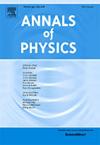Impact of EUP correction on thermodynamics of AdS black hole
IF 3
3区 物理与天体物理
Q2 PHYSICS, MULTIDISCIPLINARY
引用次数: 0
Abstract
In this paper, we investigate the effect of the extended uncertainty principle (EUP) on the thermodynamic properties and stability of a charged black hole in a Einstein–Gauss–Bonnet gravity in Anti-de Sitter () spacetime. We investigate the thermodynamic quantities (Mass, Hawking temperature, and entropy) associated with a quantum-corrected black hole. We compute the heat capacity and the Gibbs free energy, expressed in terms of horizon radii, to examine the local and global thermodynamic stability of black holes. The heat capacity, denoted by , diverges twice at a critical radius when the temperature reaches a maximum (minimum). For , and , enabling the smaller black hole to attain local stability (global stability). A subsequent Hawking-Page transition is observed between the smaller black hole and thermal space. The EUP correction significantly impacts larger black holes but has little effect on smaller ones. Furthermore, we analyze the thermodynamics of the EUP-corrected black hole modified in an extended phase space, where the cosmological constant is interpreted as the thermodynamic pressure . We calculated the critical values of the thermodynamic variables for fixed values of and and drawn the diagram. Furthermore, we examine first and second-order phase transitions by analyzing the behavior of Gibbs’s free energy–temperature plot. Below the critical point (critical pressure), a first-order phase transition is observable, concluding at the critical point, where the phase transition becomes second-order. The equation of state and critical points for black holes are analyzed, revealing similarities to those of the Van der Waals fluid.
EUP修正对AdS黑洞热力学的影响
本文研究了扩展不确定性原理(EUP)对反德西特(AdS)时空中四维爱因斯坦-高斯-邦纳引力中带电黑洞的热力学性质和稳定性的影响。我们研究了与量子校正黑洞相关的热力学量(质量、霍金温度和熵)。我们计算了热容量和以视界半径表示的吉布斯自由能,以检验黑洞的局部和全局热力学稳定性。当温度达到最大值(最小值)时,热容在临界半径r=rc处发散两次,用C+表示。对于r+<;rc, C+>;0和G+<;0,使较小的黑洞达到局部稳定(全局稳定)。在较小的黑洞和热AdS空间之间观察到随后的霍金-佩奇跃迁。EUP修正对较大的黑洞影响显著,但对较小的黑洞影响不大。进一步,我们分析了在扩展相空间中修正的eup修正黑洞的热力学,其中宇宙学常数被解释为热力学压力(Λ= - 8πP)。我们计算了α和β固定值时热力学变量的临界值,并绘制了P - v图。此外,我们通过分析吉布斯自由能-温度图的行为来检验一阶和二阶相变。在临界点(临界压力)以下,可以观察到一阶相变,在临界点处结束,相变变为二阶。分析了黑洞的状态方程和临界点,揭示了它们与范德华流体的相似之处。
本文章由计算机程序翻译,如有差异,请以英文原文为准。
求助全文
约1分钟内获得全文
求助全文
来源期刊

Annals of Physics
物理-物理:综合
CiteScore
5.30
自引率
3.30%
发文量
211
审稿时长
47 days
期刊介绍:
Annals of Physics presents original work in all areas of basic theoretic physics research. Ideas are developed and fully explored, and thorough treatment is given to first principles and ultimate applications. Annals of Physics emphasizes clarity and intelligibility in the articles it publishes, thus making them as accessible as possible. Readers familiar with recent developments in the field are provided with sufficient detail and background to follow the arguments and understand their significance.
The Editors of the journal cover all fields of theoretical physics. Articles published in the journal are typically longer than 20 pages.
 求助内容:
求助内容: 应助结果提醒方式:
应助结果提醒方式:


